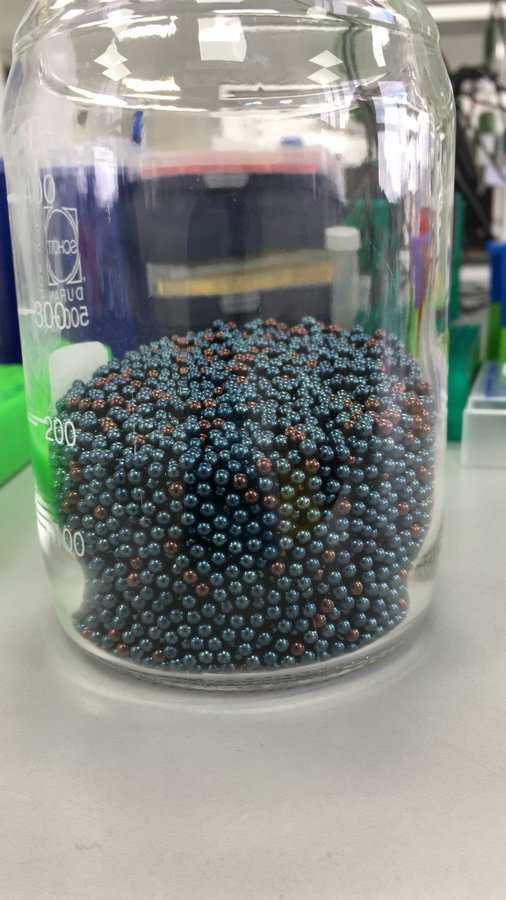96 well spin column TNA extraction from plants - CTAB method
James JN Kitson
Abstract
This protocol is designed for extracting total nucleic acids (TNA) from plant material. In reality the drying step probably means that you won't isolate plant mRNA but viral RNA (and probably plant ribosomal RNA) are recovered. This protocol is based on patent US 20110092687 A1 to allow the use of CTAB with spin columns instead of the more usual chloroform/Isoamyl alcohol method.
This protocol is significantly improved through the use of high volume multichannel electronic repeaters (e.g. a Gilson PIPETMAN M P8X1200M) or a 96 well pipette (e.g. the Gilson Platemaster) but can be performed using manual multichannel pipettes.
Attachments
Steps
Preparation of grinding tubes and buffer
Source steel beads (ball bearings) for tissue grinding (Tungsten beads are not usually necessary). We use hardened 3mm carbon steel or stainless steel bearings from simplybearings.co.uk. This protocol requires three beads per sample tube.
Beads are usually shipped coated in manufacturing oil (especially the carbon steel beads). To remove this, place beads in a borosilicate glass beaker or Duran bottle with the pouring lip and lid removed then bake for at least 12 hours at 250 oC.

Prepare CTAB lysis buffer :
| A | B | C |
|---|---|---|
| Reagent | Required cencentration in buffer | Amount per litre |
| CTAB | 2% | 20 g |
| Polyvinyl pyrrolidone | 2% | 20 g |
| Tris-HCl | 10 mM | 10 ml (of 1M stock solution) |
| EDTA | 20 mM | 40 ml (of 0.5M stock solution |
| Ammonium chloride | 1.3M | 69.54 g |
Prepare 5 ml preparation tubes (e.g. Starlab #E1450-1100) containing three 3 mm hardened steel beads in batches of 90 tubes.
Preparation of plant material
Using forceps (either disposable forceps or ethanol and flame steel forceps between samples), place ~ 50 mg of dried plant material (100 mg if using fresh) into the pre-prepared collection tubes containing the hardened steel ball bearings.
Place all sample tubes in zip-lock bags in batches of 90 (to allow for two extraction negatives, a DNA negative and three positive controls).
Freeze at -80oC until ready to proceed with the extraction.
Initial homogenisation of plant material
Place tubes while still frozen in tissue homogeniser and grind the plant material in a tissue homogeniser until homogenised.
To the plant material, add freshly-prepared CTAB lysis buffer (see below for volumes) , and place in a tube shaker, vortex mixer or tissue homogeniser (at low speed) to mix.
Incubate lysed samples in CTAB lysis buffer.
55°C
Centrifuge at 1500 x g for 5 minutes to pellet plant debris.
Transfer 350 μl of supernatant to a new 96 well filter plate (NBS biologicals #SD5006) placed on top of a 1-2 ml deep well plate. Seal the filter plate with a breathable plate seal (Starlab #E2796-3005)
Add 350 μl of CTAB buffer to two of your empty wells designated as extraction negatives.
Centrifuge at 1500 x g for 1 minute to filter and further homogenise the plant material.
TNA purification
Add 350 μl of 100% Isopropanol to each sample and vortex to mix.
Centrifuge at 1500 x g for 5 minutes to pellet plant debris.
For each sample, add as much as possible* of the supernatant from step 14 to a well in a 96-well silica membrane spin column (we use SD5007 from NBS Biologicals) sitting on top of a 1-2 ml deep well plate and cover with a breathable seal.
Centrifuge at 1500 x g for 5 minutes.
Discard flow-through or change waste receiver and add 500 μl of 70% Ethanol. Centrifuge at 1500 x g for 5 minutes.
Repeat step 15 two more times for a total of three washes. After the last wash spin for 10 minutes to dry the spin column.
Transfer the spin column to a new 0.5 ml deep well plate and add 50-100 μl of water or 10mM Tris-HCl. Incubate for 10 minutes at room temperature and centrifuge at 1500 x g for 1 minute.
The flow-through now contains the extracted TNA.

